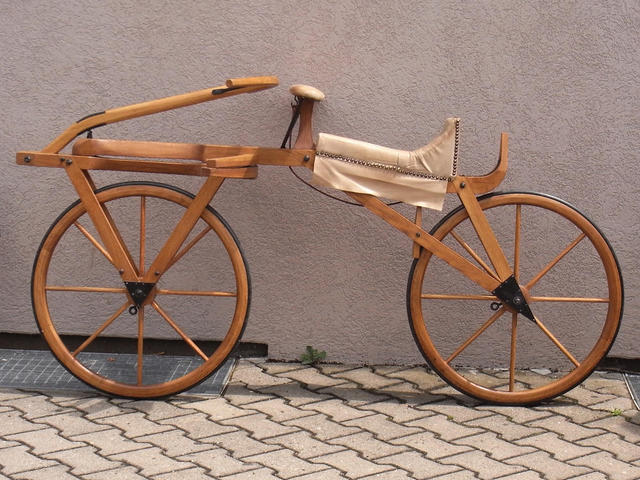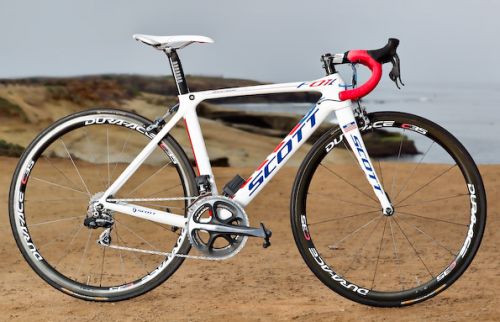The bicycle is something we each cherish as our own form of transport, be it cycling through busy industrial cities surrounded by cars and buses or flat country roads avoiding the horse dung. However we all share the same thing, that enhanced peddle powered passion to cycle.
But how far have we developed in the world today? due to pollution, money and exercise the rise in bike owners has grown massively, it’s no lie to say that almost everyone will have or will now own a bike.
So who do we owe the gratitude to for the creation of the two wheeled, seat accompanied, handle bar combined construction we call the bike? Karl Drais born on April 29th in 1785 was a German inventor, so if you’re not German bad luck your country is not responsible for creation of the bike, despite the inevitable ‘I’m sure someone else could have thought of that’, you’re wrong the bike was invented in Germany.
Anyway Drais studied at the University of Heidelberg from 1803-1805 studying architecture, agriculture and physics, so the implementation of the idea was quite clearly navigated through his studies. Now for those of you less interested in the history and more focused on fact, the first ever bicycle was invented in 1817.
And this bike was called The Laufmaschine, or The Velocipede or more commonly known to the English as The Dandy-Horse or the Hobby-Horse or quite simply the Walking Machine and even the Mega Mighty Rider was created for the first time. Now many of you may have noticed my incompetent use of the modern language in my own naming of the bike as the Mega Mighty Rider, however the other names do exist but what we can see from the numerous name count is that the term copy-right was non existent at the time, which will come into the bike industry later on. Anyway my attempted combination of modern to old will hopefully help show the amazing change in development in the history of bikes.

The Laufmaschine we shall stick with for now, was combined of two same sized wheels with the front one being steerable, now the part that struck me as, well frankly quite stupid although you must remember back in the 1800s this was the first ever viewing of a bike, so people had no knowledge what so ever, anyway the bike had no pedals, it was simply moved by the pushing of your feet to the ground, oh and it was completely made out of wood.
Amazingly the idea of peddles wasn’t introduced until 1839, the man most historians believed to have added the idea was Kirkpatrick MacMillan, Scottish born in 1812, so there’s something the Scottish and the Germans have in common along with….. Well there’s something.
The idea sprung to mind as MacMillan was watching people push the bikes with their feet, which then sprung the epiphany. Being a blacksmith he was able to create the bike with wheels himself, though MacMillan had added pedals and the iron rimmed wooden wheels there were still some needed alterations, for example the bike weighed 26 kg and had limited steering, MacMillan also failed to keep the idea hidden as other firms were putting the same bikes on the market, so, although you have to admire his contribution he made little profit himself. Going back to the copyright argument, under the Copyright, Designs and Patents Act 1988 the law of copyright was introduced in 1989, unfortunately 149 years late for Drais and also MacMillan. Altering the bike, attempting to make it better would and still didn’t cross the line of copyright, much like the whole Cadburys owns the colour purple in chocolate packaging terms, but the bike could be the same.
1860 would be the next change in bike history as the French decided to get in on the action, this was the stage that bikes became fashionable with the same design as Macmillan’s creation only with the added certainties, it used rotary cranks and pedals mounted to the front wheel hub and a completely iron frame, including the seat, so inevitably the Michaux company, the makers of the design named the bike ‘The Boneshaker’ any advertisers nightmare.

Following the bone shaker, the Penny-farthing was created, the main purpose for the high front wheel was to increase speed and what I like to see as the greater fall, you know the higher up they are the better the fall will look. This may seem unkind but I find it hard to believe that Frenchman Eugene Meyer didn’t question this at least once when he created the high front wheeled bike in 1869. So what changed you may wonder, well I sure well hope so if you’ve read this far, the tires were adapted to solid rubber and a spoon break was added by the handle bars, the frame was a single tube following the circumference of the front wheel and the bike was estimated at 16kg although many adaptations to the bike followed with slight improvements.

As the Penny- farthing created much danger the sudden craze in safety began in the late 1880’s, this leads us on to the beginning of the safety bicycle and finally the English took some action, making the world a safer place without a bunch of loonies racing around on giant bikes just crashing everywhere, although I have to admit sounds rather entertaining, Harry John Lawson was an engineer that was credible for allowing bike riders feet to touch the floor and shifting pedals to power the rear wheel rather than the front and having two wheels of identical size, the chain was added and also geared front-drives.
Despite Lawson’s great change it seemed everyone wanted to make adaption’s, the first safety bike to really hit the scene was created by John Kemp Starley in 1885 named the “Rover” and other changes developed further on as John Dunlop’s reinvention of the pneumatic bicycle tire in 1888 had made for a much smoother ride. Bikes really began to populate over the world and many adaption were being created.

As we move on to the three most commonly known bikes; the mountain bike, Hybrid and commuter bicycles and the BMX we finally see what creations came from the bike making frenzy, now the most commonly used bike, the mountain bike was believed to have been invented by a group of riders in Marin County California, this is where the real specialist parts were added, suspension was added in the early 1990’s in order to make riding in tough terrain easier, gears were also added in the 1980’s to late 2000s and disc brakes a short time after, improving the stopping power greatly.
1972 inspired the motocross generation with the creation of the BMX when children in southern California started racing their bikes across dirt tracks, the small gearing contributed to the light weight along with the small size of the bike, it was commonly made from aluminium and the wheels measured from size 16 to 20.
The road bike is known most commonly for speedy travel, it was developed, without sounding to patronising, to ride along roads, these are a few things that make the road bike so quick: The tires are narrow, high-pressure, and smooth to decrease rolling resistance, They usually use derailleur gears although fixed gear and single speed do exist, for those of you unsure to what a fix gear bike is, it is a bicycle that has a drive train with no free-wheel mechanism and if that makes no sense the clue is in the name.

Now we know a little more about the development and history of bikes, It only seems fitting to see exactly what we have accomplished with them, notice I say ‘we’…. but much gratitude must go to the makers and the record breakers mentioned in the article and hey why not every single cyclist out there, you’ve rode a bike before right?
Sam Whittingham is a Canadian cyclist that set the fastest speed ever on a flat surface, he managed to reach 83 mph in 2009 and there were many more:
Land’s End to John O’Groats: Gethin Butler on an upright cycle in 2001 managed 44h 4m 20s
Land’s End to John O’Groats to Land’s End: Ben Rockett, 27 August 2010, having ridden a total of 1,880 miles there and back in 141h 8m 0s.
One Thousand miles: On 13 March 1940 Pat Hawkins an 18 year old from Western Australia managed 4 days, 8 hours and 7 minutes.
Seven days: On Sunday 17 March 1940 again Pat Dawkins, who managed to ride 1,546.8 miles in seven days.
World Endurance record for distance in a calendar year: French born Marcel Planes managed an amazing 34,666 miles in 1911.

